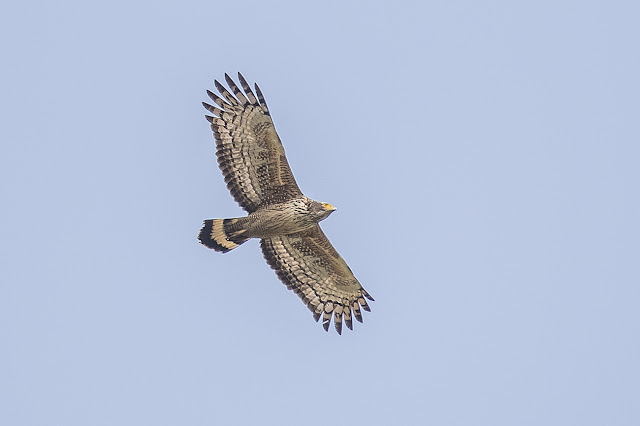Winter is a time for our regular wintering species, but occasionally we do get a surprise or two. A Blue-fronted Redstart was reported at Ngong Ping on the local birders whatsapp group, apparently someone first saw this bird sometime in January but didn't say anything about it until now. Either way this handsome male attracted attention of twitchers, birders and photographers during the weekend. It was not a shy bird, regularly perched very close to people. This is potentially a first for Hong Kong, and any first record will no doubt be scrutinised for possibilities as an ex-captive bird. Although this bird look to be in pretty good shape at first glance, some photos had shown unusual moulting pattern on the tertiaries and primaries...
Blue-fronted Redstart - male
That being said, I saw a female Daurian Redstart in much worst shape than the male Blue-fronted Redstart. Either way, the Blue-fronted Redstart was sure a fun bird to see even if this doesn't become a first for Hong Kong.
Daurian Redstart - female that was very scruffy...
Blue-fronted Redstart - male
Tai Po Kau had also been under the spotlight recently with at least five Mrs. Gould's Sunbirds coming to the flowering coral trees. This species is becoming more and more regular during winter, and this year there was a clear eruption of records throughout Hong Kong, with several more reported elsewhere. The adult male was the star of the show, on the day I visited there were no less than a hundred photographers all around the coral tree, trying to get a photo of this magnificent looking bird.
Mrs. Gould's Sunbird - adult male
It's impossible for the adult male to not be flashy...There were also a few immature males which shows a variable degree of moulting, including this bird with long blue tail feathers and patches of red on its shoulder.
Mrs. Gould's Sunbird - immature male
There was at least one female around, their greyish heads and lack of eye-rings are good features to tell them apart from female Fork-tailed Sunbirds. With all the Mrs. Gould's Sunbird around, I am sure the male Fork-tailed Sunbirds feels slightly left-out, so here's my take on a beautiful male.
Mrs. Gould's Sunbird - female
Fork-tailed Sunbird - male
The male Blue-winged Leafbird is surprisingly doing pretty well and still around. I started seeing this individual around 2014, it usually disappear throughout the year and reemerge when the coral tree is flowering.
Blue-winged Leafbird - male
I also visited Shing Mun Reservoir which yielded a female Small Niltava, it showed fairly well with a little patience. This scarce winter visitor is also becoming more and more regular in recent years and this year had also been quite a good year for them, I do hope that one day they will become a breeding species in Hong Kong.
Small Niltava - female
Red-flanked Bluetail is also having an exceptional year, whereas some years we hardly see any, this year you can hardly go anywhere without seeing at least one or two.
Red-flanked Bluetail - female
Another regular late winter visitor to Hong Kong is the Common Rosefinch, you are almost guarantee to see a few at Shek Kong Airfield from January to February. I saw two small flocks on the day I visited, with several nice looking males.
Common Rosefinch - male
Lau Shui Heung had been quite good of late, Hoiling and I visited during the week and had a very active Speckled Piculet which drummed very loudly next to the campsite. We later found it pecking and I think feeding on ants along a branch. It still amazes me how this species had took off in Hong Kong and now becoming quite common throughout New Territories.
Speckled Piculet - increasingly common in forests of Hong Kong
One of the most sought after wintering species in Hong Kong is the very colourful Fujian Niltava, we get small numbers wintering in Hong Kong every year, but seeing them is not always easy. There was a very nice looking first winter male at Lau Shui Heung which showed very well.
Fujian Niltava - a lovely looking bird
There were plenty of warblers at Lau Shui Heung, including a lot of Pallas's Leaf Warblers, this very common winter visitor are always fun to watch as they hover over plants to pick off insects on the leafs. Eastern Crowned Warbler used to be more of a passage migrant in Hong Kong, but in recent years had been wintering more and more regularly, at Lau Shui Heung I had a very cooperative individual which showed extremely well as it devoured a spider on an open branch. A more regular wintering warbler is the Two-barred Warbler, which I saw one at Lau Shui Heung as well.
Pallas's Leaf Warbler
Two-barred Warbler
Amongst the big flocks of warbler we saw a single Chestnut-crowned Warbler, a rare but regular winter visitor that is always a delight to see. There were also quite a few Rufous-faced Warbler around, of which we've been having an influx this year. These two species are perhaps amongst the prettiest warblers in Hong Kong.
Chestnut-crowned Warbler - a pretty warbler that will put a smile on any birder's face
Rufous-faced Warbler - a good year for this rarity
Thanks to Roman who brought to light a Kloss's Leaf Warbler in amongst the flock. This species looks superficially similar to
fukiensis Hartert's Leaf Warblers, also quite pale underneath, but it forages in a completely different way, whereas Hartert's are known for their nuthatch-like behaviour, Kloss's doesn't seem to do that and forages in a more traditional warbler manner. Despite all these, it's still safer to distinguish these similar species by song or call. On the three separate visits I made I only got one decent photo, but had a pretty good look and heard the diagnostic song and call.
Kloss's Leaf Warbler - rarest of the bunch...

















































